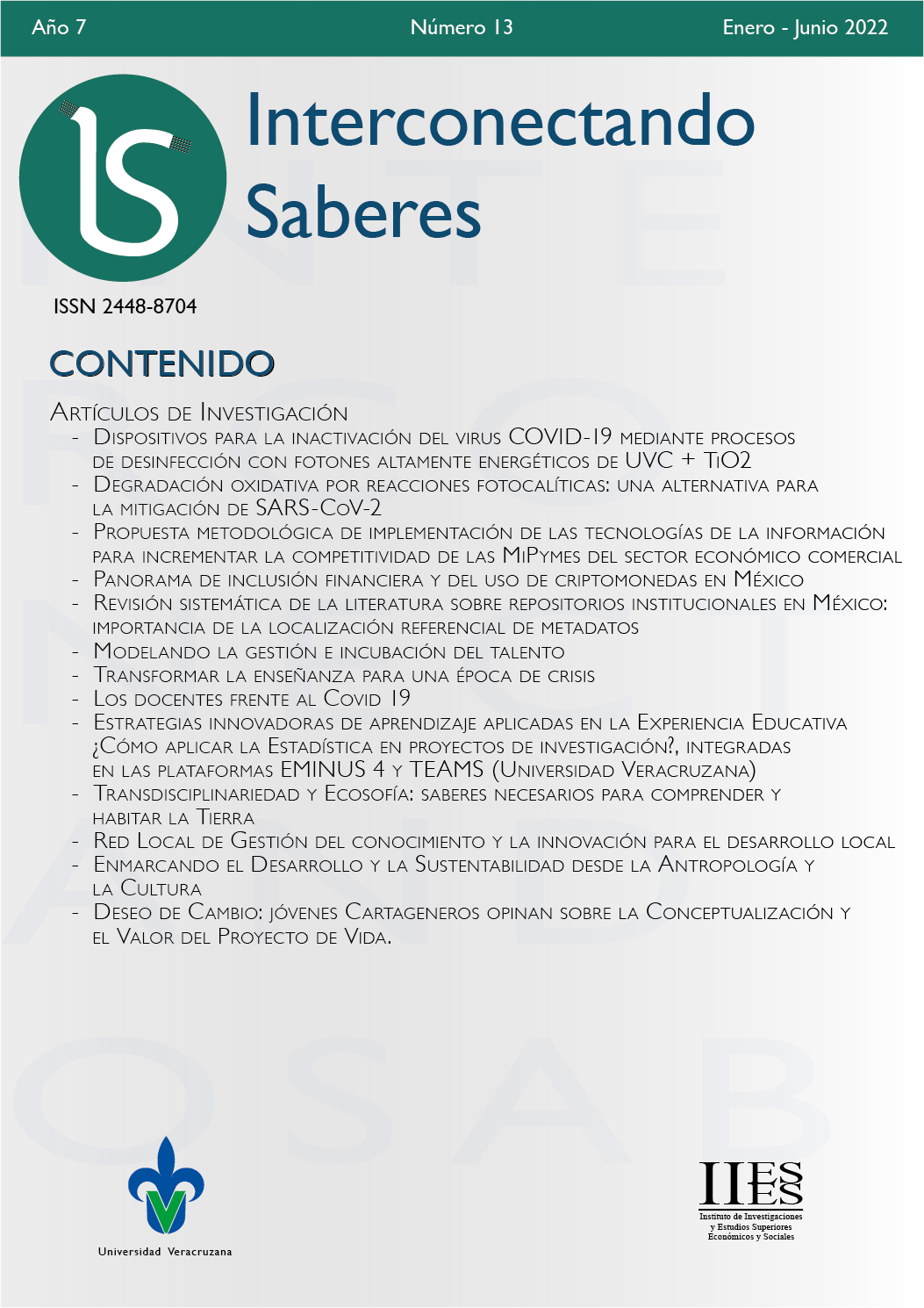Abstract
The combination of UVC light and titanium dioxide (TiO2) can be an effective measure to combat the spread of COVID 19 and reduce the possibility of contagion in public places, hospitals, educational centers, by disinfecting surfaces and means of transports where human health is at risk. In this way, the TiO2 coating being a chemically stable compound, difficult to deteriorate, with oxidative potential capable of destroying the cell membrane of bacteria, causing leaks of the cytoplasm, it can coagulate the virus protein and inhibiting its activity, for which may be a very promising method for the disinfection of the SARS-CoV-2 virus.
This proposal seeks a way to combat the spread of the COVID-19 virus, which is why it has chosen to manufacture a series of devices to carry out a disinfection of surfaces with the help of UVC light + TiO2.
References
Banerjee, S., Pillai, SC., Falaras, P., O'Shea, KE., Byrne, JA., Dionysiou, D. (2014). New Insights into the Mechanism of Visible Light Photocatalysis. J. Phys. Chem. Lett., 5, 2543-2555.
Bono, N., Ponti, F., Punta, C., Candini, G. (2021). Effect of UV Irradiation and TiO2-Photocatalysis on Airborne Bacteria and Viruses: An Overview. Materials, 14(5), 1075.
Centro Nacional de Vacunación y Enfermedades Respiratorias (NCIRD) (2021). Posibilidad de infectarse por COVID-19 después de la vacunación: infección en vacunados. División de Enfermedades Virales. Recuperado el 27 de noviembre de 2021 de https://espanol.cdc.gov/coronavirus/2019-ncov/vaccines/effectiveness/why-measure-effectiveness/breakthrough-cases.html
Chen, X., Selloni, A. (2014) Introduction: titanium dioxide (TiO2) nanomaterials. Chem. Rev., 114, 9281-9282.
Daghrir, R., Drogui, P., Robert, D. (2013) Modified TiO2 For Environmental Photocatalytic Applications: A Review. Industrial & Engineering Chemistry Research, 52, 3581-3599.
Escobedo, S., Lasa, H. (2020) Photocatalysis for Air Treatment Processes: Current Technologies and Future Applications for the Removal of Organic Pollutants and Viruses. Catalyst, 10(9), 966.
Jones, D. (2021). Germicidal UV’s Disinfecting Role in the COVID-19 Pandemic. Engineered systems. Recuperado el 27 de noviembre de 2021 de https://www.esmagazine.com/articles/101628-germicidal-uvs-disinfecting-role-in-the-covid-19-pandemic
Khataee, A., Mansoori, GA. (2011). Nanostructured Titanium Dioxide Materials: Properties, Preparation and Applications. World Scientific Publishing Co. London, SG.pp 5-7.
Kubacka,A., Fernández-García,M., Colón, G. (2012). Advanced nanoarchitectures for solar photocatalytic applications. Chem. Rev., 112, 1555-1614.
Kuhn, K., Chaberny, I., Massholder, K., Stickler, M., Benz, V., Sonntang, H., Erdinger, L. (2003). Disinfection of surfaces by photocatalytic oxidation with titanium dioxide and UVA light. Chemosphere., 53(1), 71-77.
Mackenzie, D (2020). Ultraviolet Light Fights New Virus. Engineering (Beijing, China), 6 (8), 851–853.
Mathur, G. (2021). COVID Killing Air Purifier Based on UV & Titanium Dioxide Based Photocatalysis System. SAE Technical Paper. 2021-01-0214.
Nevárez M., Espinoza P., Quiroz F., Ohtani B. (2017). Fotocatálisis: inicio, actualidad y perspectivas a través del TiO2. Avances en Química. (16) 45-59.
Ohtani, B. (2013). Cap. 5 Principle of Photocatalysis and Design of Active Photocatalysts. En New and Future Developments in Catalysis. Sola Photocalyst. 121-144.
Organización de las Naciones Unidas para la Educación, la Ciencia y la Cultura [UNESCO]. (2021). COVID-19: Problemas sociales y psicológicos en la pandemia. Network World. Recuperado el 25 de noviembre de 2021 de https://es.unesco.org/news/covid-19-problemas-sociales-y-psicologicos-pandemia
Orús A. (2021). Número de personas fallecidas a consecuencia del coronavirus a nivel mundial a fecha de 14 de noviembre de 2021, por continente. Statista. Recuperado el 25 de noviembre de 2021 de https://es.statista.com/estadisticas/1107719/covid19-numero-de-muertes-a-nivel-mundial-por-region/
Schneider, J., Matsuoka, M., Takeuchi, M., Zhang, J., Horiuchi, Y., Anpo, M., Bahnemann, DW. (2014). Understanding TiO2 photocatalysis: mechanisms and materials. Chem. Rev., 114, 9919-9986.
Villanueva J.C. (2011). Fotocatálisis con TiO2/ultravioleta y TiO2 CuSO4/visible como sistemas de desinfección para inactivar E. Coli proveniente de agua residual doméstica. Tesis de Maestría en Ciencias Biológicas, Pontificia Universidad Javeriana.
Zhang, Z., Banfield. JF. (2014). Structural characteristics and mechanical and thermodynamic properties of nanocrystalline TiO2. Chem. Rev., 114, 9613-9644.

This work is licensed under a Creative Commons Attribution-NonCommercial-NoDerivatives 4.0 International License.
Copyright (c) 2022 Diana Tonantzin Reyes Castillo, Miguel Lara Castro, Ramón Hernández Xolo, Ricardo Aurelio Ybarra Rivera

